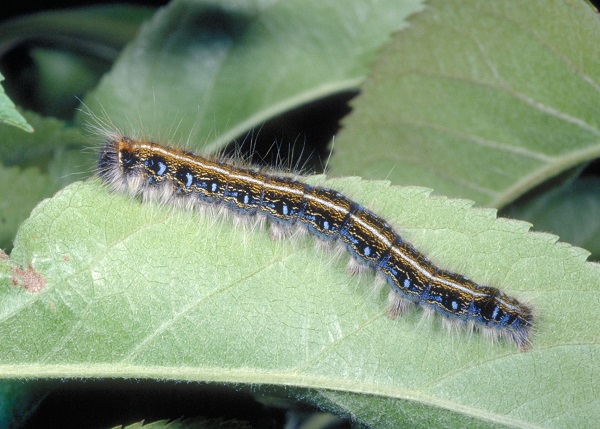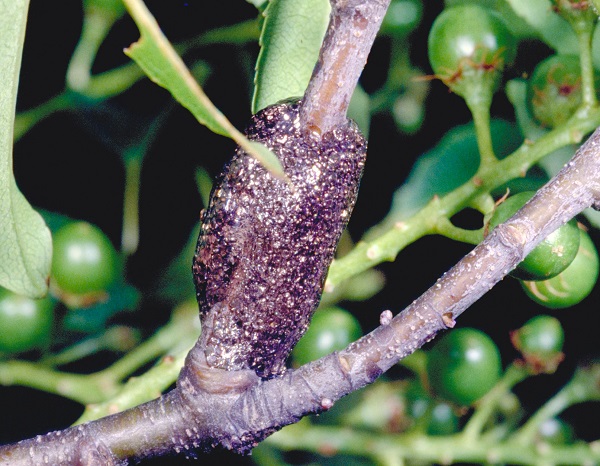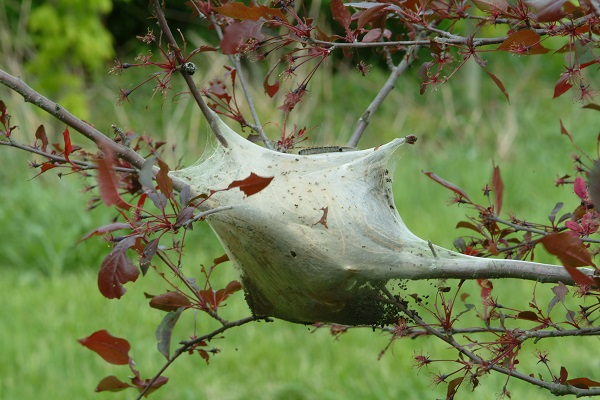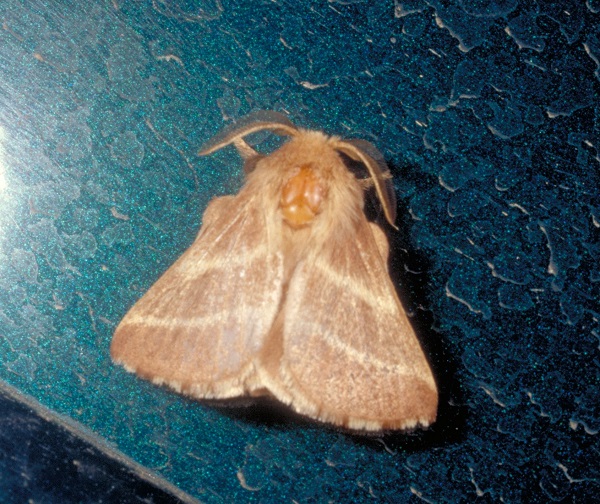Eastern Tent Caterpillar
ENTFACT-423: Eastern Tent Caterpillar | Download PDF
by Ric Bessin, Extension Specialist
University of Kentucky College of Agriculture
The eastern tent caterpillar, Malacosoma americanum, is a pest native to North America. Populations fluctuate from year to year, with outbreaks occurring every several years. Defoliation of trees, building of unsightly silken nests in trees, and wandering caterpillars crawling over plants, walkways, and roads cause this insect to be a pest in the late spring and early summer. Eastern tent caterpillar nests are commonly found on wild cherry, apple, and crabapple, but may be found on hawthorn, maple, cherry, peach, pear and plum as well.

Figure 1. An eastern tent caterpillar.
While tent caterpillars can nearly defoliate a tree when numerous, the tree will usually recover and put out a new crop of leaves. In the landscape, however, nests can become an eyesore, particularly when exposed by excessive defoliation. The silken nests are built in the crotches of limbs and can become quite large.
Larvae cause considerable concern when they begin to wander to protected places to pupate. Frequently they are seen crawling on other types of plants, walkways, and storage buildings. They are a nuisance and can create a mess when they are squashed on driveways, sidewalks, and patios. But keep in mind that no additional feeding or damage is done by the wandering caterpillars.
Insecticides are generally ineffective against mature larvae.
Eastern tent caterpillar nests are frequently confused with fall webworm nests. Unlike the tent caterpillar, fall webworm nests are located at the ends of the branches and their loosely woven webs enclose foliage while the tents of the eastern tent caterpillar do not. While there may be some overlap, fall webworm generally occurs later in the season.
Biology
The eastern tent caterpillar overwinters as an egg, within an egg mass of 150 to 400 eggs. These masses are covered with a shiny, black varnish-like material and encircle branches that are about pencil-size or smaller in diameter.

Figure 2. Eastern tent caterpillar egg masses are wrapped around small twigs.
The caterpillars hatch about the time the buds begin to open, usually in early March. These insects are social; caterpillars from one egg mass stay together and spin a silken tent in a crotch of a tree. Caterpillars from two or more egg masses may unite to form one large colony. During the heat of the day or rainy weather, the caterpillars remain within the tent. They emerge to feed on leaves in the early morning, evening, or at night when it is not too cold.

Figure 3. An eastern tent caterpillar nest.
The larvae are hairy caterpillars, black with a white stripe down the back, brown and yellow lines along the sides, and a row of oval blue spots on the sides. As the larvae feed on the foliage, they increase the size of the web until it is a foot or more in length. In 4 to 6 weeks the caterpillars are full grown and 2 to 2-1/2 inches long. At this time, they begin to wander away individually from the nest in search of protected areas to spin a cocoon. The cocoon is about 1 inch long and made of closely woven white or yellowish silk and is attached to other objects by a few coarser threads.

Figure 4. An adult male eastern tent moth.
The adult moth emerges from the cocoon about 3 weeks later. The moth is reddish-brown with two pale stripes running diagonally across each forewing. Moths mate and females begin to lay eggs on small branches. The eggs will hatch next spring. There is just one generation per year.
Management
- Natural enemies play an important role in reducing eastern tent caterpillar numbers in most years. Caterpillars are frequently parasitized by various tiny braconid, ichneumonid, and chalcid wasps. Several predators and a few diseases also help to regulate their populations. This, in part, accounts for the fluctuating population levels from year to year.
- Prevention and early control is important. Removal and destruction of the egg masses from ornamentals and fruit trees during winter greatly reduces the problem next spring. In the early spring, small tents can be removed and destroyed by hand. Larger tents may be pruned out and destroyed or removed by winding the nest upon the end of a stick. Burning the tents out with a torch is not recommended since this can easily damage the tree.
- Young caterpillars can be killed by applying an insecticide containing Bacillus thuringiensis var kurstaki. Other insecticides include carbaryl, and malathion. Larvae within the tents are protected beneath the webbing and are more difficult to kill with an insecticide.
Revised: 11/19
CAUTION! Pesticide recommendations in this publication are registered for use in Kentucky, USA ONLY! The use of some products may not be legal in your state or country. Please check with your local county agent or regulatory official before using any pesticide mentioned in this publication.
Of course, ALWAYS READ AND FOLLOW LABEL DIRECTIONS FOR SAFE USE OF ANY PESTICIDE!
Images: Ric Bessin, University of Kentucky Entomology except tent in tree photo: R. L. Anderson, USDA Forest Service, copyright 1995
